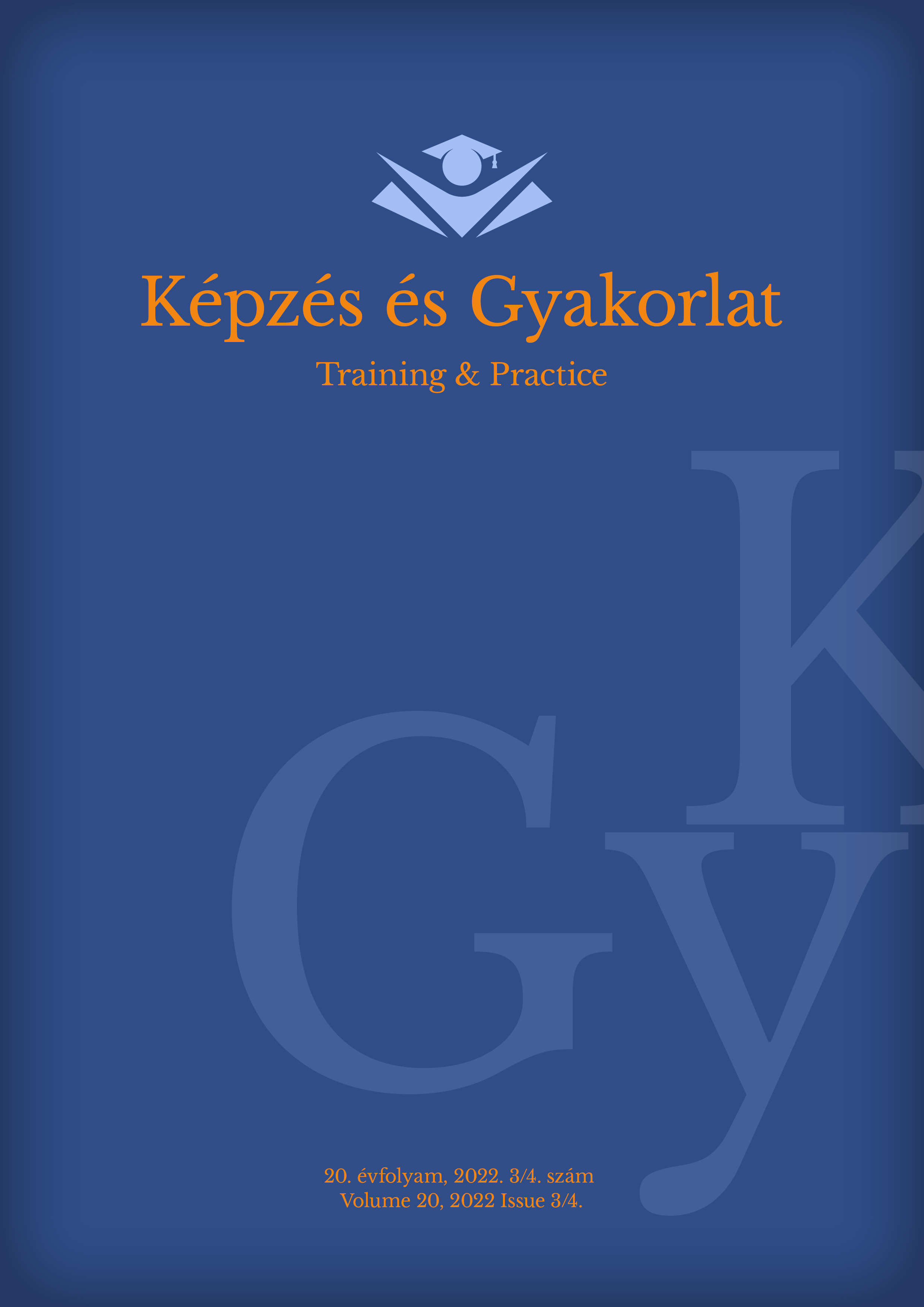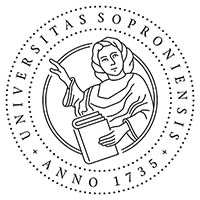Az oktatási célú szabadulószobák módszertani lehetőségei egyetemi hallgatóknál
DOI:
https://doi.org/10.17165/tp.2022.3-4.24-35Kulcsszavak:
kollaboratív problémamegoldó kompetencia, szabadulószoba, módszertani megújulásAbsztrakt
Az oktatási célú szabadulószoba egyik fő előnye a tanulói motiváció növelése a tananyag elsajátítása érdekében, közben az interperszonális készségek fejlesztése is elengedhetetlen a módszer alkalmazása folyamán. Kutatásunk során ennek az innovatív oktatási módnak a módszertani lehetőségeit vizsgáljuk egyetemi hallgatók körében. A kutatásunk fő kérdése az, hogyan valósítható meg a kollaboratív problémamegoldó kompetencia mérése a szabadulószoba által, illetve mi jellemzi a szabadkai (Szerbia) Magyar Tannyelvű Tanítóképző Kar hallgatóinak kollaboratív problémamegoldó kompetenciáját. Tanulmányunkban a szakirodalmi ismereteket felhasználva, az oktatási célú szabadulószobák módszertani lehetőségeit ismertetjük. Munkánk során egy saját fejlesztésű, oktatási szabadidős szabadulószoba-játék bemutatását is vázoljuk.
Hivatkozások
Astin, A. W. (1977). Four critical years: Effects of college beliefs, attitudes and knowledge. Jossey-Bass.
Berthod, F., Bouchoud, L., Grossrieder, F., Falaschi, L., Senhaji, S., & Bonnabry, P. (2020). Learning good manufacturing practices in an escape room: Validation of a new pedagogical tool. Journal of Oncology Pharmacy Practice, 26(4), 853–860. https://doi.org/10.1177/1078155219875504
Cain, J. (2019). Exploratory implementation of a blended format escape room in a large enrollment pharmacy management class. Currents in Pharmacy Teaching and Learning, 11(1), 44–50. https://doi.org/10.1016/j.cptl.2018.09.010
Caprara, G. V., Barbaranelli, C., Borgogni, L., & Perugini, M. (1993). The “big five questionnaire”: A new questionnaire to assess the five factor model. Personality and Individual Differences, 15(3), 281–288. https://doi.org/10.1016/0191-8869(93)90218-R
Clarke, S. J., Peel, D. J., Arnab, S., Morini, L., Keegan, H., & Wood, O. (2017). EscapED: A Framework for Creating Educational Escape Rooms and Interactive Games to For Higher/Further Education. International Journal of Serious Games, 4(3), https://doi.org/10.17083/ijsg.v4i3.180
Davis, B. G. (1993). Tools for Teaching. Jossey-Bass Inc.
Eukel, H., Frenzel, J., Frazier, K., & Miller, M. (2020). Unlocking Student Engagement: Creation, Adaptation, and Application of an Educational Escape Room Across Three Pharmacy Campuses. Simulation & Gaming, 51(2), https://doi.org/10.1177/1046878119898509
Fodor, S., Raven, J., & Klein, B. (2018). Scrambled Adaptive Matrices (SAM) – a new test of eductive ability. Psychological Test and Assessment Modeling, 60(4), 441–482.
Friedrich, C., Teaford, H., Taubenheim, A., Boland, P., & Sick, B. (2019). Escaping the professional silo: An escape room implemented in an interprofessional education curriculum. Journal of Interprofessional Care, 33(5), 573–575. https://doi.org/10.1080/13561820.2018.1538941
Gokhale, A. A. (1995). Collaborative learning enhances critical thinking. Journal of Technology Education, 7(1), https://doi.org/10.21061/jte.v7i1.a.2
Griffin, McGaw, P., & Care, E. (Eds.). (2014). Assessment and Teaching of 21st Century Skills. Springer Netherlands. https://doi.org/10.1007/978-94-017-9395-7
Hesse, F. Care, E., Buder, J., Sassenberg, K., & Griffin, P. (2015). A Framework for Teachable Collaborative Problem Solving Skills. In Assessment and teaching of 21st century skills educational assessment in an information age (pp. 37–56). https://doi.org/10.1007/978-94-017-9395-7_2
Kovács, E., Pintér Krekić, V., Major, L. (2020). Tanítói attitűdvizsgálat a kooperatív tanulás hatásáról a matematikában nyújtott teljesítményre (Teacher attitude survey on the impact of cooperative learning on performance in mathematics), Évkönyv. Tanulmánygyűjtemény, 15(1), 56–68.
Kozéki, B. (1980). A motiválás és motiváció összefüggéseinek pedagógiaipszichológiai vizsgálata. Akadémiai Kiadó.
Laal, М. & Ghodsi, S. M. (2012). Benefits of collaborative learning, Procedia Social and Behavioral Sciences, 31(1), 486–490. https://doi.org/10.1016/j.sbspro.2011.12.091
Lalović, Z. (2009). Naša škola - metode učenja/nastave u školi, Zavod za školstvo, Podgorica
Marshall, L., O’Neil, H. F., & Chen, A. (2005). Teamwork Skills: Assessment and Instruction. Innovations in Instructional Technology. Routledge.
Miletić, J. (2007). Kooperativna ili saradnička nastava, Obrazovna tehnologija, 3, 61–74.
McFadden, C., & Porter, S. (2018). AISOS: A Reproducible Model for Institution-Wide 3D Imaging.
Neubert, J., Mainert, J., Kretzschmar, A., & Greiff, S. (2015). The assessment of 21st century skills in industrial and organizational psychology: Complex and collaborative problem solving. Industrial and Organizational Psychology: Perspectives on Science and Practice, 8(2), 238–268. https://doi.org/10.1017/iop.2015.14
Nicholson, S. (2018). Creating Engaging Escape Rooms for the Classroom. Childhood Education 94(1), 44–49. https://doi.org/10.1080/00094056.2018.1420363
Nicholson, S. (2015). Peeking Behind the Locked Door: A Survey of Escape Room Facilities White Paper available at http://scottnicholson.com/pubs/erfacwhite.pdf
Nicholson, S. (2016). The State of Escape: Escape Room Design and Facilities. Paper presented at Meaningful Play 2016. Lansing, Michigan, USA. http://scottnicholson.com/pubs/stateofescape.pdf
Pan, R., Lo, H., & Neustaedter, C. (2017). Collaboration, Awareness, and Communication in Real-Life Escape Rooms (pp. 1353–1364). https://doi.org/10.1145/3064663.3064767
Panitz, T. (1996). A Definition of Collaborative vs Cooperative Learning. Deliberations, London Metropolitan University.
Pásztor-Kovács, A. (2020). A csoportmunkához szükséges képességek vizsgálata: a Kollaboratív képes-ségek kérdőív validálása. Magyar Pedagógia, 120(3), 269–296. https://doi.org/10.17670/MPed.2020.3.269
Pásztor-Kovács, A. (2019). A kollaboraáció hateékonysaágaának felteételei és mérési lehetőségei. Iskola-kultúra, 29(9), 3–20. https://doi.org/10.14232/ISKKULT.2019.9.3
Pásztor-Kovács, A. (2015). Kollaboratív problémamegoldó képesség: egy új, integratív elméleti keret. Iskolakultúra, 15(2), 3–16. https://doi.org/10.17543/ISKKULT.2015.2.3
Réthy, E. (2003). Motiváció, tanulás, tanítás. Miért tanulunk jól vagy rosszul? Nemzeti Tankönyvkiadó.
Rosen, Y., & Foltz, P. W. (2014). Assessing collaborative problem solving through automated technologies. Research and Practice in Technology Enhanced Learning, 9(3), 389–410.
Snyder, J. (2018). A Framework and Exploration of a Cybersecurity Education Escape Room. Theses and Dissertations. https://scholarsarchive.byu.edu/etd/6958
Tóth L., Király Z. (2006). Új módszer a kreativitás megállapítására: A Tóth-féle Kreativitás Becslő Skála (TKBS). Magyar Pedagógia, 106(4), 287–311.
Veldkamp, A., Daemen, J., Teekens, S., Koelewijn, S., Knippels, Marie-Christine P. J., & van Joolingen, W. R. (2020). Escape boxes: Bringing escape room experience into the classroom. British Journal of Educational Technology, 51(4), 1220-1239. https://doi.org/10.1111/bjet.12935
Letöltések
Megjelent
Folyóirat szám
Rovat
License
Copyright (c) 2022 Elvira Kovács, Helena Manojlovic

This work is licensed under a Creative Commons Attribution-NonCommercial-NoDerivatives 4.0 International License.








